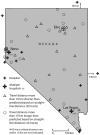A Nationwide Comparison of Driving Distance Versus Straight-Line Distance to Hospitals
- PMID: 24273346
- PMCID: PMC3835347
- DOI: 10.1080/00330124.2011.583586
A Nationwide Comparison of Driving Distance Versus Straight-Line Distance to Hospitals
Abstract
Many geographic studies use distance as a simple measure of accessibility, risk, or disparity. Straight-line (Euclidean) distance is most often used because of the ease of its calculation. Actual travel distance over a road network is a superior alternative, although historically an expensive and labor-intensive undertaking. This is no longer true, as travel distance and travel time can be calculated directly from commercial Web sites, without the need to own or purchase specialized geographic information system software or street files. Taking advantage of this feature, we compare straight-line and travel distance and travel time to community hospitals from a representative sample of more than 66,000 locations in the fifty states of the United States, the District of Columbia, and Puerto Rico. The measures are very highly correlated (r2 > 0.9), but important local exceptions can be found near shorelines and other physical barriers. We conclude that for nonemergency travel to hospitals, the added precision offered by the substitution of travel distance, travel time, or both for straight-line distance is largely inconsequential.
Keywords: accessibility; detour index; proximity; travel distance.
Figures
References
-
- ArcGIS, version 9.3. Redlands, CA: ESRI;
-
- Buhl J, Hicks K, Miller E, Persey S, Alinvi O, Sumpter D. Shape and efficiency of wood ant foraging networks. Behavioral Ecology and Sociobiology. 2009;63(3):451–60.
-
- Burdette HL, Whitaker RC. Neighborhood playgrounds, fast food restaurants, and crime: Relationships to overweight in low-income preschool children. Preventive Medicine. 2004;38(1):57–63. - PubMed
Grants and funding
LinkOut - more resources
Full Text Sources


